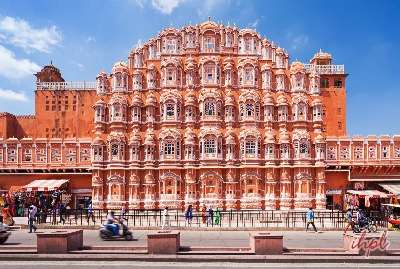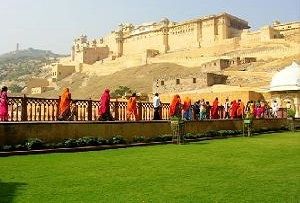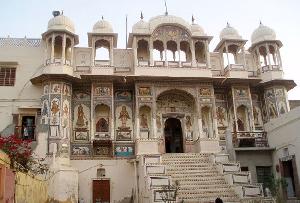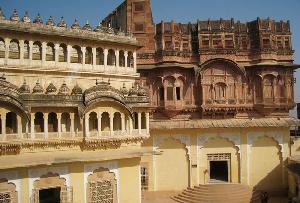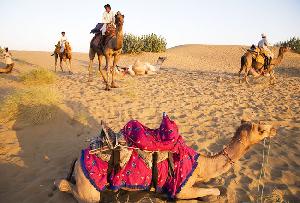Jaipur, the Pink City, where history meets elegance through its iconic palaces and bustling bazaars. Let Indian Holiday design your perfect Jaipur holiday, blending authentic local insights with unmatched customization. Begin your adventure today with our Jaipur Travel Guide and exclusive Jaipur tour packages.
Jal Mahal is a renowned monument in Jaipur, known for its exquisite Maharaja-era architecture. This stunning palace sits in the middle of Man Sagar Lake and was designed as a retreat for leisure and enjoyment.
A unique feature of Jal Mahal is that the first four floors are submerged beneath Man Sagar Lake, with only the top floor visible above the water. Visitors to the palace can appreciate both its architectural magnificence and its insight into Rajput traditions and culture. As a result, this palace is one of the most popular tourist attractions in Jaipur.
Complete guide about Jal Mahal in Jaipur, Rajasthan
Jal Mahal Jaipur History
The construction of the Jal Mahal lacks official records, but legends suggest that Maharaja Sawai Pratap Singh commissioned the palace in 1799. He Wanted to use it as a hunting lodge for his duck-shooting expeditions rather than a residence. The creation of Man Sagar Lake is attributed to him, having been formed by constructing a dam between the surrounding hills.
Another tale says that Maharaja Madho Singh built Jal Mahal in the 1750s as a hunting lodge. Later, his son Madho Singh II played a key role in beautifying the interiors in the 18th century. He added courtyard grounds, which are still part of the Mahal.
In the 18th century, Maharaja Jai Singh II undertook a renovation of the lake. However, the palace began to deteriorate due to water logging and sewage issues. Restoration efforts were made to restore it to its former glory.
With this guide, discover additional places to visit in Jaipur during your trip.
Jal Mahal Architecture
Jal Mahal features five stories, with four of them submerged under Man Sagar Lake, leaving only the top floor visible.
Constructed from red sandstone, Jal Mahal displays a blend of Rajput and Mughal architectural styles. The palace's four corners each have an octagonal dome (chhatri), and the central terrace is crowned by a large rectangular dome in Bengali style.
Location of Jal Mahal
- Jal Mahal Jaipur address: Amer, Jaipur, Rajasthan
- Distance from Jaipur:
- 4 km north of Jaipur on the main Jaipur-Amer road.
- 8 km from Amer Fort.
- Access: Can be reached from the Jaipur-Delhi National Highway No.8, connecting Jaipur with Delhi and Mumbai.
Jal Mahal Entry Fees
- Entry Fee: Free (Government banned entry fee)
- Viewing: Pathway around Man Sagar Lake allows visitors to view the palace.
Jal Mahal Jaipur Timings
- Visiting Hours: Open any time of day.
- Recommended Time: 6:00 AM to 6:00 PM.
- Night Illumination: Palace is illuminated at certain times; check the official tourism website for details.
If you want to enjoy this, check the details on the official tourism website. Additionally, it looks amazing under a starry night sky. Choose your preferred time to visit the palace based on your desired experience.
Explore our Jaipur tour Packages for guided tours and travel convenience.
Best Time to Visit Jal Mahal Palace
- Ideal Months: October to March (Pleasant weather).
- Monsoon Season: Rain enhances the beauty of the sandstone and attracts migratory birds, making it a popular spot for birdwatchers.
Get insight into Famous and Local favourites through this Jaipur Travel Guide
Features of Jal Mahal
This stunning architectural wonder of Jaipur is a testament to the city's rich history. Its beauty, especially when lit at night, and unique features continue to make it a standout attraction in Jaipur. Some of the major highlights of the palace are;
1. Art Gallery at Level 1 of Jal Mahal: The first level of Jal Mahal features an art gallery showcasing paintings by local artists. Several artworks depict Jaipur's cultural heritage, including the Teej festival and royal celebrations.
2. Chameli Bagh: Chameli Bagh is a notable terrace garden at Jal Mahal, known for its beauty and architectural significance.
3. Tibaris: On the terrace of Jal Mahal, Tibaris features unique designs that enhance the palace's aesthetic appeal. The four Tibaris in the palace are shown here:
- Anand Mahal Tibari – This is famous for its red, gold, and blue floral motifs, patterns and Mughal art forms.
- Badal Mahal Tibari – This represents the monsoon clouds and the elements experienced in the season, such as raindrops and lily pools.
- Raas Niwas Tibari – Inspired by Lord Krishna, the ceiling depicts paintings of Krishna and Gopis performing Rasleela.
- Gulabi Tibari – It features pink and white stucco, which recreates the designs of the Sarvatobhadra pavilion from City Palace.
4. The Scented Chamber: Jal Mahal's Scented Chamber offers visitors a sensory experience of royal court fragrances and features an exhibition celebrating the region's natural beauty and culture.
Explore 7 days Rajasthan mewar tour package, 12 days Golden Triangle tour with Darjeeling
Things to do at Jal Mahal Jaipur
You are not allowed inside the palace but can still enjoy a romantic walk witnessing it. Here are some popular things you can enjoy at Jal Mahal –
Photography: Capture the palace with the hills as a backdrop, especially at night when it looks even more magical. The monsoon season adds to its charm, making it one of Jaipur’s most photographed spots.
Enjoy the view: Relax on the boundary wall, enjoying the view of the lake and palace.
Street Shopping: There are many hawkers selling mojris, traditional Rajasthani jewellery, shoes, handicraft items, etc., you can buy.
Camel Rides: Wear traditional Rajasthani attire and experience camel rides. Additionally, get your photo taken to remember the moment.
Bird watching: Jal Mahal is home to several migratory birds, including the great crested grebe, pintail, kestrel, and pilchard.
Browse through our Udaipur Tour Packages from Delhi, Udaipur Tour Packages from Bangalore
Places to Visit near Jal Mahal
You won't spend much time here as there's not much to do. So, here are some nearby places to visit after Jal Mahal Jaipur –
- Ajmeri Gate Jaipur (7.7 km – 25 minutes)
- Jantar Mantar (6.2 km – 20 minutes)
- Hawa Mahal (6.0 km – 19 minutes)
- City Palace Jaipur (6.1 km – 20 minutes)
- Birla Mandir Jaipur (9.8 km – 33 minutes)
- Nahargarh Fort (9.6 km – 24 minutes)
- Amer Fort (5.4 km – 14 minutes)
How to reach Jal Mahal
- Upon arriving in Jaipur, taxis, buses, and auto-rickshaws are readily available to take you to Jal Mahal, one of the city's top tourist attractions.
- The nearest bus stop is Shahpura Bagh, located just 200 meters from Jal Mahal.
- You can also book a cab from one of the leading car rental companies in Jaipur to explore the city at your own pace.
Check out Rajasthan Tour Packages, Shekhawati Tour Packages, Bundi Tour Packages, Sariska National Park Tour Packages




